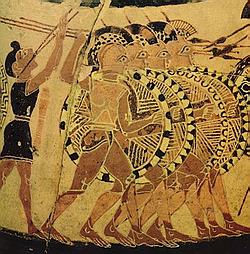Hoplites
 From Conservapedia
From Conservapedia 
The Hoplites (Greek:ὁπλίτης) were Greek heavy Infantry during the period around 6th to 2nd century BC.
The hoplite armor was quite varied. Most hoplites were millitas that were conscripted by the state in times of need - the armor hoplites was nothing more than the clothes on their back. As city states grew richer, they could afford better equipment - thus most "middle class" hoplites in later times would've been equipped with linothorax (harded linen armor) or leather. Only the rich upper class could afford quality armor such as bronze. These hoplites wore full-face helmets probably made of bronze and wielded a heavy shield of wood covered in bronze. Their preferred weapon was a spear, and a short sword as a backup weapon. In battle they often used the phalanx formation, which was essentially a wall of overlapping shields and spears and they moved as a cohesive unit. The name derives from Hoplon, the formal name of their shields. The shield was commonly known as an Aspis.
Traditionally hoplites were not professional soldiers, but often men of ordinary professions. They would purchase their own armor, which could lie unused for years, and the quality of the armor would reflect the material wealth of the bearer. They would be summoned to fight in the event of their city going to war. Hoplite warfare often consisted of "pushing matches" when one hoplite formation would try to push back the opposing hoplite formation. During these relatively short pushing matches, causalities were usually light, and since the leaders/generals would often be in the front rank, the outcome of the battle would be strategically decisive. Heavy infantry hoplites were especially against the Persian army which contained no heavy infantry to speak of. Even the "heavy infantry" 10,000 immortals wore a light metal scale tunic, and wielded wicker shields not suited to hand-to-hand combat. In the case of the Battle of Marathon, due to their thick bronze armor the Athenians often crushed the Persian troops to death.
Possibly the most renowned hoplites were those of the city of Sparta on the Peloponnese, who famously wore scarlet red capes and kept their hair long. Trained from birth these warriors were professionals, rather than the levied troops of their fellow Grecian cities. They were famous for their courage and their skill, but could often commit acts we would today consider atrocities. Their most famous hour was arguably the Battle of Thermopylae. The terrain of Thermopylae suited the phalanx formation perfectly, as the narrow confines of the pass meant that the Persian's superior numbers could not be brought to bear, nor could the vulnerable flanks of the phalanx be exploited by the Persian cavalry.
The traditional Greek-style phalanx was superseded by the Macedonian-style phalanx under Philip II, who was the father of Alexander the Great. The main improvement was use of the sarissa, a long pike as opposed to the shorter spear used by the Greek states.
External links[edit]
- hoplites.co.uk
Categories: [Military History]
↧ Download as ZWI file | Last modified: 02/19/2023 02:25:35 | 31 views
☰ Source: https://www.conservapedia.com/Hoplites | License: CC BY-SA 3.0
 ZWI signed:
ZWI signed: KSF
KSF